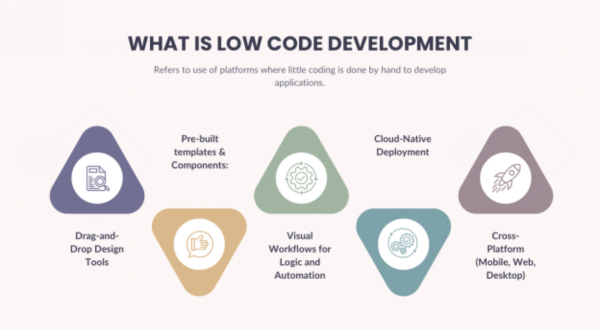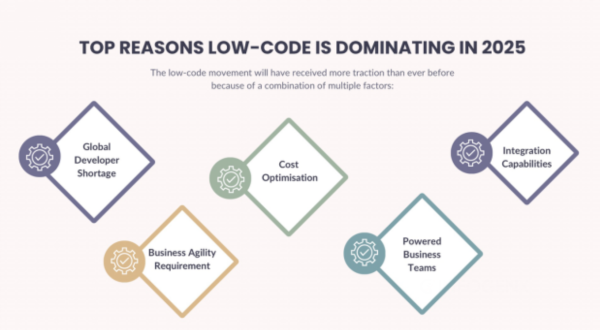
Why Low-Code Development Is Surging in 2025
The nature of business application development is changing seismically in 2025. The long-established code-heavy methods are being overtaken by low-code platforms, which deliver apps faster with minimal manual code. It's a response to real business needs: time to market, cost efficiency, and democratized innovation.
Low-code platforms enable enterprises to create scalable apps using visual interfaces, drag-and-drop tools, and pre-built components—helping startups and Fortune 500s alike in digital transformation.
What is Low-Code Development? A 2025 Guide
Low-code development uses platforms that require minimal hand-coding. Developers design applications using GUI and configuration tools instead of manually writing code.
Core Features of Low-Code Platforms in 2025:
● Drag-and-Drop Design Tools
Allows users to build UI visually without writing code. Minimizes UI errors and ensures design consistency.
● Pre-built Templates & Components
Comes with templates like dashboards and login pages, speeding up development while maintaining consistency and best practices.
● Visual Workflows for Logic and Automation
Users define logic using flowcharts and visual editors instead of backend code.
● Cloud-Native Deployment
Supports easy deployment with auto updates, global availability, and cloud integration.
● Cross-Platform Support
Apps work on mobile, desktop, and web automatically with responsive design tools.
Top Reasons Low-Code Is Dominating in 2025
- Global Developer Shortage: Empowers non-tech users (citizen developers).
- Business Agility: Faster prototyping and app delivery.
- Cost Optimization: Saves on development, hiring, infrastructure.
- Empowered Business Teams: Business teams can build their own tools.
- Integration Capabilities: Easy API-based integration with systems like SAP, Salesforce.
Use Cases of Low-Code
- Employee & HR Portals: Leave and performance tracking apps.
- Supply Chain: Inventory management, vendor automation.
- Finance: Invoice approval, compliance tracking.
- Healthcare: Appointment scheduling, patient monitoring tools.
Low-Code vs Traditional App Development
| Feature | Low-Code | Traditional |
| Speed | Weeks | Months |
| Cost | Low | High |
| Flexibility | Moderate to High | Very High |
| Skill Requirement | Low to Medium | High |
| Maintenance | Platform-Supported | Developer-Intensive |
| Scalability | Improved | Custom Built |
Low-Code and Intelligent Automation
- AI-powered chatbots for customer service
- RPA for data entry and invoice automation
- ML models for predictive analytics via drag-and-drop AI builders
Challenges of Low-Code & Solutions
- Governance: Need for internal security and policy frameworks.
- Scalability Limits: Some apps still require traditional coding.
- Integration Complexity: Older systems need APIs or middleware.
- Vendor Lock-In: Choose open platforms with code export.
Future of Low-Code (2025+)
- AI-Driven Development: Natural language-based UI & logic generation.
- Low-Code DevOps: Better version control, CI/CD integration.
- Industry-Specific Platforms: Tailored for verticals like fintech or healthcare.
- Fusion Teams: Hybrid IT-business teams.
- Education Integration: Included in academic curriculum.
Top Platforms in 2025
- OutSystems: Scalable enterprise-grade apps.
- Mendix: Large-scale digital transformation.
- Zoho Creator: Budget-friendly, easy-to-use.
- Appian: Automation + AI integration.
- Salesforce Lightning: Best for CRM-based low-code apps.
Final Thoughts: Low-code is now a strategic necessity. It helps businesses stay competitive, agile, and customer-focused in 2025 and beyond.
Frequently Asked Questions (FAQs)
Q1: Can low-code be used for complex enterprise apps?
A: Yes, modern low-code platforms offer scalability, integration, and DevOps support.
Q2: How secure are low-code applications?
A: Top platforms follow best practices, but internal governance is essential.

Thank you! You have subscribed to our newsletter.
